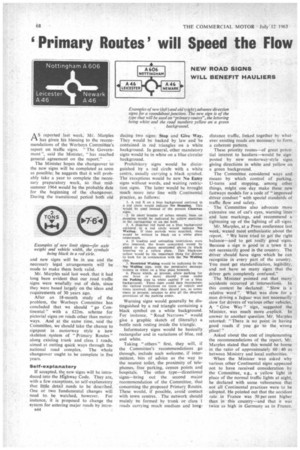'Primary Routes will Speed the Flow
Page 70

If you've noticed an error in this article please click here to report it so we can fix it.
As reported last week, Mr. Marples has given his blessing to the recommendations of the Worboys Committee's report on traffic signs. "The Government", said the Minister, " has reached general agreement on the report."
The Minister hopes the changeover to the new signs will be completed as soon as possible; he suggests that it will probably take a year to complete the necessary preparatory work, so that midsummer 1964 would be the probable date for the beginning of the changeover. During the transitional period both old and new signs will be in use and the necessary legal arrangements will be made to make them both valid.
Mr. Marples said last week that it had long been evident that our road traffic signs were woefully out of date, since they were based largely on the ideas and requirements of 30 years ago.
After an 18-month study of the problem, the Worboys Committee has concluded that we should "go Continental" with a £22m. scheme for pictorial signs on roads other than motorways. And at the same time, said the Committee, we should take the chance to signpost in motorway style a new skeleton system of "Primary Routes" along existing trunk and class I roads, aimed at cutting quick ways through the national road complex. The whole changeover ought to be complete in five years.
Self-explanatory If accepted, the new signs will be introduced into the Highway Code. They are, with a few exceptions, so self-explanatory that little detail needs to he described. One or two fundamental changes will need to. be watched, however. For instance, it is proposed to change the system for entering major roads by intro
e44 clueing two signs: Stop and Give Way. They would be backed by law and be contained in red triangles on a white background. In general, other mandatory signs would be in white on a blue circular background.
Prohibitory signs would be distinguished by a red click with a white centre, usually carrying a black symbol. The exceptions would be new No Entry signs without words, and waiting restriction signs. The latter would be brought much more into line with Continental practice, as follows: Warning signs would generally be distinguished by a red triangle containing a black symbol on a white background. For instance, "Road Narrows" would give a graphic sketch of (literally) a bottle neck resting inside the triangle.
Informatory signs would be basically rectangular and in variations of blue, red and white.
Taking "others" first, they will, if the Committee's recommendations go through, include such welcome, if intermittent, bits of advice as the way to the nearest toilet, the proximity of telephones, free parking, census points and hospitals. The other type—directional signs—bring out the second major recommendation of the Committee, that concerning the proposed Primary Routes. These would, if possible, avoid contact with town centres. The network should mainly be formed by trunk or class 1 roads carrying much medium and long
distance traffic, linked together by whatever existing roads are necessary to form a coherent pattern.
These priority routes—of great potential interest to hauliers—would be signposted by new motorway-style signs giving directions in white and yellow on a green background.
The Committee considered ways and means by which control of parking. U-turns and stopping, among other things, might one day make these new fastways models for a code of "improved driver conduct" with special standards of traffic flow and safety.
' The Committee also advocate more extensive use of cat's eyes, warning lines and lane markings, and recommend a tightening up of the lighting of all signs.
Mr. Marples, at a Press conference last week, waxed most enthusiastic about the report. "We have tried to get the right balance—and to get really good signs. Because a sign is good in a town it is not necessarily good in the country. The driver should have signs which he can recognize in every part of the country. You must get standardization, legibility, and not have so many signs that the driver gets completely confused."
The Minister pointed out that many accidents occurred at intersections. In this context he declared: Slow is a relative word". What was slow for a man driving a Jaguar was not necessarily slow for drivers of various other vehicles. A "Give Way!' sign, suggested the Minister, was much more explicit. In answer to another question Mr. Marples retorted: "There is no point in having good roads if you go to the wrong place!"
Asked about the cost of implementing the recommendations of the report, Mr. Marples stated that this would be borne in the ratio of approximately 60 : 40 as between Ministry and local authorities.
When the Minister was asked why various other Continental signs appeared not to have received consideration by the Committee, e.g., a yellow light in place of the normal traffic lights at night, he declared with some vehemence that not all Continental practices were to be adopted. He pointed out that the accident rate in France was 50 per cent higher than in this country—and that it was twice as high in Germany as in France.




















































































































